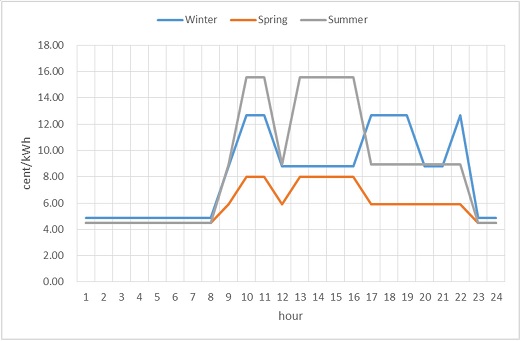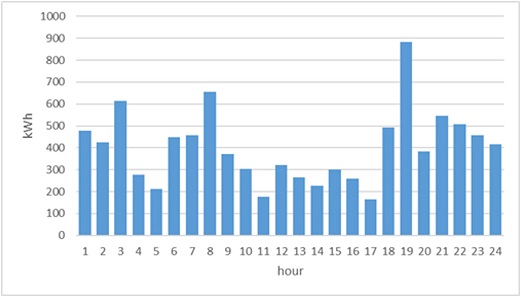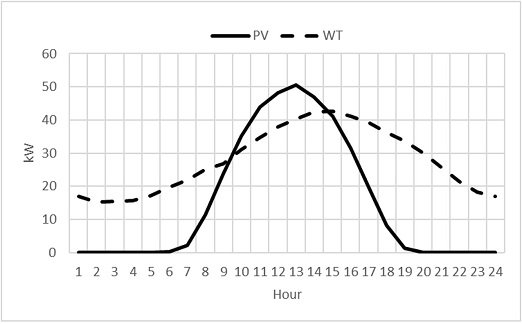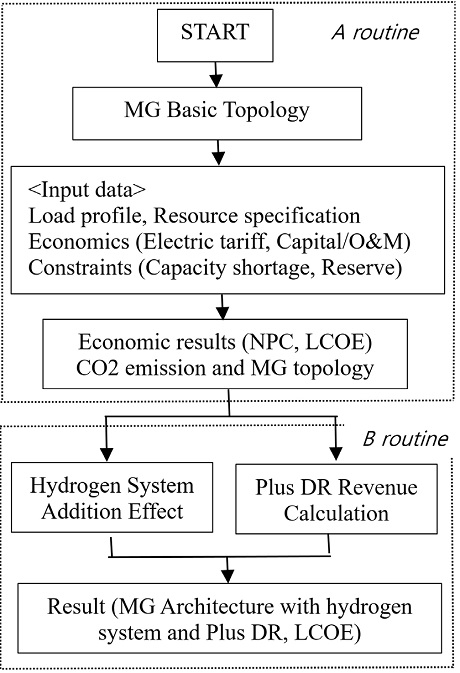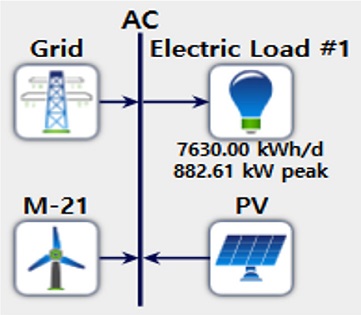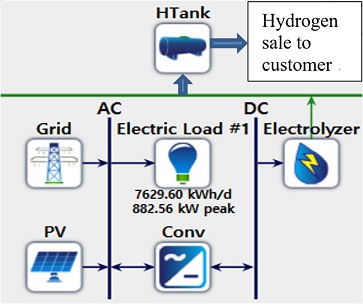
Online publication date 25 Mar 2022
Feasibility Study of the Introduction of Hydrogen System and Plus DR on Campus MG
Copyright © 2022 by the New & Renewable Energy
This is an Open Access article distributed under the terms of the Creative Commons Attribution Non-Commercial License (http://creativecommons.org/licenses/by-nc/3.0) which permits unrestricted non-commercial use, distribution, and reproduction in any medium, provided the original work is properly cited.
Abstract
The renewable energy based MG is becoming one of the prominent solutions for greenhouse gas and constructing less power lines. However, how to procure the economics of MG considering the CO2 emission and utility network impact is one of major issues as the proportion of renewable resource increases. This paper proposes the feasibility study scheme of campus MG and shows that the LCOE and CO2 emission can be reduced by utilizing the excess power and introducing hydrogen system and plus DR. For this, the three cases: (a) adding the PV and selling excess power to utility, (b) producing and selling hydrogen using excess power, and (c) participating in plus DR are considered. For each case, not only the topology and component capacity of MG to secure economic feasibility, but also CO2 emission and utility network effects are derived. If an electrolyzer with a capacity of 400 kW participates in plus DR for 3,730hours/year, the economic feasibility is securable if plus DR settlement and hydrogen sale price are more than 7.08¢/kWh and 8.3USD/kg or 6.25¢/kWh and 8.6USD/kg, respectively. For this end, continuous technical development and policy support for hydrogen system and plus DR are required.
Keywords:
Microgrid, LCOE, Grid Indicator, Excess Power, Plus Demand Response1. Introduction
The renewable energy resource based MG has grown to be prominent solution for greenhouse gas reduction, procurement of reliable electric power supply, and cumbersome transmission line construction.[1,2] MG, which is comprised of renewable power sources such as PV or WT, energy storage, monitoring, and controlling facilities, is expected to be disseminated faster due to the economic, technical, environmental advantages. The topology and operation system of MG is determined by renewable resource and site. It is affected by utility network connection and electric power load profile, too. In the other way round, the MG can affect more to the connected distribution system as their capacity becomes bigger. Considering the connected electric power system characteristics, optimal topology, operation strategy and business models of MG are suggested.[3,4] Microgrids in residential, industries and university districts increasingly use renewable energy to improve technical, financial and environmental performance.[5~7] In particular, research on introducing MG to campus is being actively conducted worldwide.[8] This paper investigates optimal schemes necessary for establishing campus MG, which is composed of educational and residential load, and connected to utility network. The remainder of this paper is structured as follows. The section 2 reviews relevant literatures on the campus MG and utilization of excess power in MG. The section 3 analyzes the correlations and output profile of renewable energy sources, including electric tariff and load. The section 4 shows the feasibility study procedure of campus MG. The section 5 estimates the effect of campus grid MG, which applies renewable energy sources, from the three perspectives: economics, utility network effect and environment.
2. Literature Review
There are wide range of goals and characteristics for building campus MG. The campus MG of Genoa University is composed of PV, GT, and battery. It aims 50% of self-supply rate in hot water and electric power demands.[9] University of California San Diego with 725 buildings established a MG, which includes GT, PV, FC and battery. It is expected that 92% of electric load of the university can be covered which amount to eight million US dollars.[10] The Illinois Institute of Technology installed a MG to achieve increased electric power load and adequacy in electric power supply. It is comprised of GT, WT, PV, and battery. The total net savings for the eight years (2016-2023) with an escalation rate of 5% is $11,749,916.[11] The Chubu University built a MG to cope with earthquake and tsunami. The system consists of FC, PV, and battery. The MG system is expected to cover 25% of peak load and 15% of power consumption in average. The system can save eight to ten million yen/year.[12] There are also several campus MG cases built in Korea. The MG of Seoul National University is composed of combined heat and power, PV and battery. The goal of MG is to provide 20% of electricity power demand with four hours of independent operation.[13] Jeonnam National University established a MG which is designed to simulate electric power trading among small MGs within the university.[14] Most of these studies are aimed at reducing MG operating costs and improving electric power self-sufficiency, and do not suggest strategies to secure economic feasibility to recover facility investment costs. Meanwhile, various studies are being conducted through the efficient use of excess power in MG. The possibility of excessive power (i.e., over generated quantity of electricity than demand due to uncontrollable feature of renewable resources) becomes bigger as the proportion of renewable resources increases. How to utilize this power is one of the major issue from the economic and technical point of view and thus large number of research tackle this topic.[15] The representative solutions is consuming electricity power by register element,[16] or supplying excessive power to utilities,[17,18] or generating hydrogen using electrolytic cell.[19] For example, reference[19] suggests strategy of generating and storing hydrogen with excessive power. And later, it can either be sold to market for FC vehicle or be used to regenerate electricity power which can be sold through network. That paper proposes only MG economic feasibility with a hydrogen storage system in the power market. This paper analyzes the MG economic feasibility of participation in the hydrogen storage system and plus DR more comprehensively, and the main contributions are as follows:
- • An economical, utility network and environmental impact evaluation methodologies considering the introduction of a hydrogen production system and plus DR at a utility network connected campus MG based on PV are presented.
- • For Campus MG subject to the TOU electric tariff, the results of economic simulation by optimal MG topology by HOMER and utilization strategy of excess power are presented.
- • Through this, a business model case is presented when making investment decisions for campus MG expansion.
3. TOU Tariff and Load Profile
3.1 TOU Tariff
Fig. 1 shows hourly education electricity tariff (high voltage A/option-I) structure[20] in winter (January), spring (May), and summer (July) respectively of Korea. In overall, the tariff level is high during daytime of summer season whereas it is low from 11:00 pm to 8:00 am in all seasons. The electricity tariff in peak load is 15.54¢/kWh, and off-peak load tariff is 4.48 ¢/kWh from June to August, during which period the tariff level is comparatively high. Comparatively lower electricity tariff is charged from March to May, and from September to August.
3.2 Load Profile
Fig. 2 illustrates the historical hourly load profile of target campus which is located in isolated place and so most of faculties as well as students live in dormitory. In overall, the load level during night is comparatively high, which is due to pre-installed 68 kW of PV resource and usage of electricity for heating and cooling in dormitory. The electric cooling and heating facility capacity is 507 kW. Especially, the high usage pattern of energy in 3:00 am, 8:00 am and 7:00 pm reflects regular heating or cooling operation. The annual peak demand is 883 kW, and the daily average power consumption is 7,630 kWh.
3.3 WT and PV Output Profile and Capacity Factor
Fig. 3 shows average hourly output profile of WT and PV (each capacity is 100 kW) of target campus. The WT tends to generate bigger output during afternoon in average and generate more power during winter season in average. The PV resource generates power from 6:00 am to 6:00 pm and tends to generate highest level of output around noon. The maximum power output occurs in November whereas the average output is highest in April. Table 1 provides yearly output and capacity factor of WT and PV resources at target campus area. The capacity factor of WT is higher than that of PV by 1.83 times because the target campus site is located near to seashore.
3.4 Load, PV/WT and Electric Tariff Correlation
The Pearson correlation-coefficients[21] among electric load, WT resource, and PV resource output are estimated to understand degree of load mismatch by equation (1)
| (1) |
where, Sxx is a variance of x, Sxy is a covariance between x and y. Table 2 provides the correlation analysis result among the electric load, PV resource, and WT resource output.
The electric load has negative correlation with electric tariff (-0.3086), WT (-0.1187) and PV (-0.5032) resource outputs under 99% of statistical confidence level. This result confirms that the observed daily load in Fig. 3 has reverse profile from the electric tariff profile and output profiles of renewable resources such as PV, WT. The electric load is comparatively high from 6:00 pm to 10:00 pm and around 8:00 am due to the cooling and heating load in dormitory, which is the unique load characteristics different from the other campus MG studies.[22,23] In terms of the correlation between electricity tariff and renewable power output, PV is 0.4491, which is higher than WT, indicating that PV can greatly contribute to reducing LCOE of MG. On the other hand, the PV shall generate during daytime. That is why the importance of handling excess electricity power reveals critical implication from the simulation result of this paper.
4. Methodology
4.1 HOMER Tool
HOMER Tool used in this paper is a program developed by NREL in the United States and is used to design the optimal topology of MG consisting of DG and renewable power sources. Economic (i. e, NPC, LCOE), technology, environmental characteristics can be evaluated for MG topology cases input by the user. In addition, network connected MG and independent MG can be considered.
4.2 Economics Analysis Procedure
Fig. 4 shows the feasibility evaluation procedure of MG by HOMER (A routine) and EXCELL (B routine). The MG basic topology is first defined by user, and load profile, investment/operation maintenance costs of MG components, and the related constraints are established. Based on this, NPC, LCOE, and CO2 emissions of MG are calculated by HOMER. Next, the profits from the introduction of the hydrogen system and Plus DR are calculated by EXCELL and added to the LCOE calculated by HOMER to derive improved LCOE and MG Topology.
5. Case 1: Campus MG with PV/WT addition
5.1 MG Topology and PV/WT Input
Fig. 5 illustrates the basic topology of campus MG, which consists of utility network (GRID), WT (M-21) and PV. Table 3 shows the HOMER input data for initial investment cost, O&M (operation and maintenance) cost, year of life. It is assumed that PV related costs include the converter cost. And the LCOE of MG varies depending on the handling of excessive electric power (EPt) at t, which equation is expressed as follows:
| (2) |
Where Prewgen,t and total loadt mean the output of PV or WT and MG load at time t respectively. In the base case, we assume the excessive power is sold to utilities network at the same price with purchasing price. The 5.5% discount rate[24] is applied for the LCOE calculation of MG
5.2 LCOE Sensitivity of MG
Table 4 shows the HOMER simulation result of LCOE in case of WT and PV resources capacity addition to campus MG.
In the current state without expansion of PV and WT, the average electricity purchase price from network is 7.89¢/kWh (LCOE-1). But the LCOE of MG will reach to 8.17¢/kWh when the PV resource capacity increased at 300 kW. And after that, it begins to decrease. For example the LCOE is 7.75¢/kWh when the PV resource capacity becomes 700 kW. This is because the reduction in power purchase costs from network due to PV expansion surpasses the increase in PV capex and O&M costs. Also, the LCOE of MG increases to 10.1¢/kWh as WT resource increase to 1,000 kW and decrease. It is proved that PV resource is superior to WT resource in the target area for campus MG. Considering the site constraints, etc., we determine 500 kW PV as a maximum capacity in practice, which is the 8.03¢/kWh (LCOE-2) in this paper. Additionally, we estimate two externalities of installing PV: CO2 reduction and effects which include the MG peak shaving and load variability on utility network.
5.3 Reduction Effect
We estimated net decrease of CO2 if the 500 kW PV are used in substitution for purchasing electricity power from utilities network. For this, marginal CO2 emission coefficient of utility electricity is assumed as 0.4594 tCO2eq g/MWh based on the national energy statistics.[26] Approximately 240 tons/year of CO2 reduction is expected if 500 kW PV resources are installed and operated in campus MG, which would substitute 523,282 kWh/year of electricity power purchase. As a result, MG itself showed a CO2 saving effect of about 19%. In addition, when excess power is sold to the utility network, it contributes to the reduction of CO2 of the utility by replacing part of the entire load of the network. The degree of contribution will vary depending on the method of processing excess power in MG, which is not considered in this paper.
5.4 Effect on Utility Network
A ‘net load (Pnl,t)’ is calculated by subtracting PV output (Ppvgen,t) from the total electric load (total loadt) at time t (i.e, Pnl,t = total loadt-Ppvgen,t). The variability of net load impacts to the power quality (i.e, voltage quality) of the utility network. This impact can be measured in various way and one of which is GI.[27] In order to measure the expected effect of campus MG on the utility network, we apply the GI, which equation is as below:
| (3) |
Where, Pnl,t represent for the net load at time t, which can be either net sale or purchase of electric power from utility network to MG. The lower GI implies MG makes smaller impact to utility network. Table 5 shows the estimation result of GI on the target campus MG.
The SD and mean increases at 1.72 and 1.19 times respectively, while total peak load is same to the net peak load because the PV output has no effect on the peak of total load. So, resulting GI shows 3.91 which result implies the campus MG gives the adverse effect in terms of net load variability when PV is added to MG. The main reason for increased SD and mean of variability is the negative correlation coefficient between campus electric load and output of PV resource. If PV 500 kW is expanded in current MG, CO2 emissions decrease, but LCOE of MG including power purchase costs and GI increase. As an alternative to this negative effect, this paper proposes the introducing of hydrogen system.
6. Case 2 : Campus MG with PV and Hydrogen System
6.1 MG Topology and Hydrogen System Input
In this case, the conditions for securing economic feasibility in the case of producing and selling hydrogen instead of selling excess power generated by PV 500 kW to a utility is derived. In HOMER, there is no economic analysis function for hydrogen production and sales cases by excess power. Therefore, only excess power is calculated by HOMER, and EXCELL tool is used for hydrogen production and economy by excess power. Table 6 shows the input data for electrolyzer and hydrogen storage tank for calculating the LCOE by HOMER. And the efficiency of electrolyzer is assumed as 85%.
And Fig. 6 illustrates revised campus MG topology including hydrogen system for utilizing the excessive electric power. The excess power for each hour is calculated by HOMER, and as a result, the average excess power for each year and daily is 150,146 kWh and 413 kWh, respectively, and the maximum excess power is 364 kW. Based on this, hydrogen production is calculated reflecting the efficiency of the electrolyzer. The maximum hydrogen production per hour is calculated as 8 kg and the average daily hydrogen production is calculated as 9 kg. Therefore, in this paper, the electrolyzer and converter capacity are assumed as shown in Table 7 in consideration of excess power and facility reserve. In addition, the Htank capacity is assumed to be 10 kg in consideration of the daily average hydrogen production and sales.
6.2 LCOE Sensitivity of MG
The capital investment expenditures (Capex) for installing hydrogen causes higher LCOE of MG, while the hydrogen sale makes it lower. We calculated LCOE of campus MG with hydrogen system based on range of hydrogen sales price and Capex scenarios. The result is provided in Table 8, where the scenario-1 is estimation result from the input value of Table 6, and scenario-2 is another case with 50% of Capex. For reference, if PV 500 kW is not added, the LCOE is 7.89¢/kWh (LCOE-1). And LCOE of MG is 8.03¢/kWh (LCOE-2) when selling excess power generated by adding the PV 500 kW.
LCOE is showing a decreasing trend as hydrogen sales prices increase and capex and O&M costs decrease. However, despite the hydrogen sales price being 15 USD/kg and the capex and O&M costs being reduced to 50%, LCOE is 8.89¢/kWh, which is uneconomical than LCOE-1 when all power is purchased from a power company without installing PV 500 kW. It can be seen that in order to secure economic feasibility when introducing the hydrogen system, that is, to lower LCOE to LCOE-1, hydrogen sales prices or capex and O&M costs must be further reduced. For example, if the hydrogen sales price is 15USD/kg and the capex and O&M costs are reduced to 19% or less compared to the levels shown in Table 6, the hydrogen system in MG will be able to secure economic feasibility despite the low capacity factor of 4.3%. However, satisfying these conditions is expected to involve a lot of uncertainty. Accordingly, a strategy to secure economy by participating in plus DR is proposed in the following section 7.
6.3 Effect on Utility Network
As shown in Table 9, the SI is reduced to 3.47 due to the effect of processing excess power by the hydrogen system. Compared to the case 1, both SD and Mean decreased, contributing to the improvement of power quality, but did not affect the reduction of peak load. Accordingly, compensation for SI improvement should be accompanied through incentives for net volatility reduction or policies for ancillary services.
And in this case, the CO2 emission reduction effect by MG's own power consumption is the same as that of the 500 kW PV installation case.
7. Case 3 : Economic Improvement by Hydrogen System and Plus DR
7.1 Plus DR Overview and Participation Conditions
Plus DR is a demand response system that receives a compensation if electricity is used at a set time, and operates opposite to conventional DR. That is, it is a system[30,31] that stabilizes power supply and demand by increasing power demand when power supply is excessive due to renewable power generation, etc. In Korea, it has been operating on a pilot basis in Jeju since March 2021. Therefore, in this paper, based on the case of PG&E in the United States,[30] the economic feasibility of receiving power by participating in Plus DR and using it for hydrogen production is evaluated. Economic feasibility improves as the electrolyzer capacity, participation time and the settlement unit price of plus DR increases. It is practically very difficult to predict how long the annual participation time will be depending on the renewable output and power demand in the target system. In this regard, the time of occurrence of renewable output constraints in Jeju Island in 2030 is predicted to be 3,730 hours per year.[32] Therefore, in this paper, it is assumed that 400 kW of electrolyzer participates in plus DR for 933 hours/year (25% of Jeju Island's renewable output power constraint time) based on the electrolyzer capacity shown in Table 7. Accordingly, the capacity factor of electrolyzer increased to 15%.
7.2 LCOE Sensitivity of MG
Table 10 shows the simulation results of LCOE of MG according to the change in the hydrogen sales price and plus DR settlement unit price. The plus DR settlement unit price in Table 9 is set based on reference.[33] The economic feasibility is securable if plus DR settlement and hydrogen sale price are 6.25 ¢/kWh and 8.6USD/kg or 7.08¢/kWh and 8.3USD/kg or higher, respectively.
8. Conclusion
In this paper, the economic evaluation procedure for the expansion of renewable power for campus MG is presented, and the effect is derived by applying campus MG. To this end, the correlation between power demand, electric tariff, and renewable power is analyzed, and PV is confirmed to be effective in reducing LCOE of MG under the TOU tariff. Accordingly, when the PV is expanded, LCOE and CO2 emission decreases. However, the volatility of the net load can effect on the electric power quality and the excess power increases. As a case for the economic utilization plan of excess power, LCOE, CO2 emissions, and system indicator at the introduction of the hydrogen system and plus DR are analyzed. Through this, the conditions to ensure economic feasibility in MG where the hydrogen system and plus DR are introduced is proposed. Despite these conditions, economic feasibility in MG may vary depending on various policy, economic and technical variables. In this regard, this study may have some limitations in real system data and market price variables, which conditions may differ in other places outside of Korea. Also, different result may be drawn due to environmental condition such as solar energy, wind speed, temperature etc. We expect further study with other market, and environment data for broadened understandings in handling excessive electricity output from MG.
Subscript
| NREL : | national renewable energy laboratory |
| GT : | gas turbine |
| FC : | fuel cell |
| HTank : | hydrogen tank |
| DR : | demand response |
| NPC : | net present cost |
| LCOE : | levelized cost of electricity |
| MG : | micro grid |
| PV : | photovoltaic |
| WT : | wind turbine |
| SD : | standard deviation |
| DG : | diesel generator |
| TOU : | time of use |
Acknowledgments
This study was conducted with the funds of the Ministry of Trade, Industry and Energy in 2019 with the support of the Korea Institute of Energy Technology Evaluation and Planning (KETEP) as a new energy project and a global talent development project (project number: 20194010000090). This work was supported by the 2020 Research Fund of the KEPCO International Nuclear Graduate School (KINGS), Republic of Korea.
References
-
Hirsch, A., Parag, Y., and Guerrero, J., 2018, “Microgrids: A review of technologies, key drivers, and outstanding issues”, Renew. Sust. Energ. Rev., 90, 402-411.
[https://doi.org/10.1016/j.rser.2018.03.040]

-
Na, M.S., and Kim, J.O., 2019, “Optimal sizing and location of renewable energies in a microgrid”, New. Renew. Energy, 15(1), 55-61.
[https://doi.org/10.7849/ksnre.2019.3.15.1.055]

-
Hatziargyriou, N., 2014, “Microgrids: Architectures and control”, Wiley, 25-203.
[https://doi.org/10.1002/9781118720677]

- Borghese, F., Cunic, K., and Barton, P., 2018, “Microgrid Business Models and Value Chains”, Schneider Electric White Paper, https://perspectives.se.com/e-books/microgrid-business-models, .
-
Del Granado, P.C., Wallace, S.W., and Pang, Z., 2014, “The value of electricity storage in domestic homes: a smart grid perspective”, Energy Systems, 5(2), 211-232.
[https://doi.org/10.1007/s12667-013-0108-y]

-
Zhang, K., Li, J., He, Z., and Yan, W., 2018, “Microgrid energy dispatching for industrial zones with renewable generations and electric vehicles via stochastic optimization and learning”, Phys. A: Stat. Mech. Appl., 501, 356-369.
[https://doi.org/10.1016/j.physa.2018.02.196]

-
Del Granado, P.C., Pang, Z., and Wallace, S.W., 2016, “Synergy of smart grids and hybrid distributed generation on the value of energy storage”, Applied Energy, 170, 476-488.
[https://doi.org/10.1016/j.apenergy.2016.01.095]

-
Muqeet, H.A., Munir, H.M., Javed, H., Shahzad, M., Jamil, M., and Guerrero, J.M., 2021, “An energy management system of campus microgrids: State-of-the-art and future challenges”, Energies, 14(20), 6525.
[https://doi.org/10.3390/en14206525]

-
Bonfiglio, A., Delfino, F., Pampararo, F., Procopio, R., Rossi, M., and Barillari, L., 2012, “The smart polygeneration microgrid test-bed facility of Genoa University”, Proceeding of 2012 47th International Universities Power Engineering Conference (UPEC), 4-7.
[https://doi.org/10.1109/UPEC.2012.6398656]

-
Washom, B., Dilliot, J., Weil, D., Kleissl, J., Balac, N., Torre, W., and Richter, C., 2013, “Ivory tower of power: Microgrid implementation at the university of California, San Diego”, IEEE Power and Energy Magazine, 11(4), 28-32.
[https://doi.org/10.1109/MPE.2013.2258278]

-
M. Shahidepour, 2014, “Perfect power prototype for illinois institute of technology final technical report”, United States, https://www.osti.gov/biblio/1191135, .
[https://doi.org/10.2172/1191135]

- Kei, F., Takashi, O., Katsuhiro, K., Taizo, S., Kenichi, K., and Shigeo., N., 2013, “Multi-building energy management system at Chubu University for a smart community”, Shimizu Corporation, 90, 93-100.
-
Cho, S. C., Hah, T. K, Haan, S. J., and Han, H. S., 2016, “A Study for Development and Demonstration of Campus Micro Grid in Seoul National University”, Proceeding of The Korean Institute of Electrical Engineers 2016 Summer Conference, 504-505, https://www.kiee.or.kr/pages_publications/electronic_library.vm
[https://doi.org/10.4313/JKEM.2016.29.8.505]

- Kim, B.C., Jeong, H.Y., and Kim, H.Y., 2018, “Campus microgrid-EMS system considering multi-MG power trading”, Proceeding of Symposium on Micrpgrids, https://microgrid-symposiums.org/wp-content/uploads/2018/07/05_poster_2018_HyeYoonJeong.pdf, .
-
Ismail, M.S., Moghavvemi, M., Mahlia, T.M.I., Muttaqi, K.M., and Moghavvemi, S., 2015, “Effective utilization of excess energy in standalone hybrid renewable energy systems for improving comfortability and reducing cost of energy: a review and analysis”, Renew. Sust. Energ. Rev., 42, 726-734.
[https://doi.org/10.1016/j.rser.2014.10.051]

-
Mousavi G., S.M., 2012, “An autonomous hybrid energy system of wind/tidal/microturbine/ battery storage”, Int. J. Electr. Power Energy Syst., 43(1), 1144-1154.
[https://doi.org/10.1016/j.ijepes.2012.05.060]

-
Demiroren, A., and Yilmaz, U., 2010, “Analysis of change in electric energy cost with using renewable energy sources in Gökceada, Turkey: An island example”, Renew. Sust. Energ. Rev., 14(1), 323-333.
[https://doi.org/10.1016/j.rser.2009.06.030]

-
Ranjevaa, M., and Kulkarnia, A.K., 2012, “Design optimization of a hybrid, small, decentralized power plant for Remote/Rural areas”, Energy Procedia, 20, 258-270.
[https://doi.org/10.1016/j.egypro.2012.03.026]

-
Mayyas, A., Wei, M., and Levis, G., 2020, “Hydrogen as a long-term, large-scale energy storage solution when coupled with renewable energy sources or grids with dynamic electricity pricing schemes”, Int. J. Hydrog., 45(33), 16311-16325.
[https://doi.org/10.1016/j.ijhydene.2020.04.163]

- Korea Electric Power Corporation (KEPCO), “Electric Rates Table”, https://cyber.kepco.co.kr/ckepco/front/jsp/CY/E/E/CYEEHP00101.jsp, .
- Wikipedia, “Pearson correlation coefficient”, https://en.wikipedia.org/wiki/Pearson_correlation_coefficient
-
Kristiawan, R.B., Widiastuti, I., and Suharno, S., 2018, “Technical and economical feasibility analysis of photovoltaic power installation on a university campus in Indonesia”, Proceeding of MATEC Web of Conferences, 197(2), 08012.
[https://doi.org/10.1051/matecconf/201819708012]

- Ajuzie Uchechukwu, C., Azubogu, A.C.O., and Inyiama, H.C., 2019, “Modeling and simulation of campus solar-diesel hybrid using HOMER grid (SPGS Nnamdi Azikiwe university Awka campus as a case study)”, THE IJES, 8(12), 97-108, https://www.theijes.com/papers/vol8-issue12/Series-2/K08120297108.pdf, .
- Lee, K.D., and Kim, K.H., 2020, “Establishment and operation of a mid- to long-term power generation cost forecast system to expand the supply of renewable energy. (1/5)”, Korea Energy Economics Institute, https://www.keei.re.kr/web_keei/d_results.nsf/main_all/A10FCB3438C55F4349258669004FC436/$file/%EA%B8%B0%EB%B3%B8%202020-21_%EC%9E%AC%EC%83%9D%EC%97%90%EB%84%88%EC%A7%80%20%EA%B3%B5%EA%B8%89%ED%99%95%EB%8C%80%EB%A5%BC%20%EC%9C%84%ED%95%9C%20%EC%A4%91%EC%9E%A5%EA%B8%B0%20%EB%B0%9C%EC%A0%84%EB%8B%A8%EA%B0%80(LCOE)%20%EC%A0%84%EB%A7%9D%20%EC%8B%9C%EC%8A%A4%ED%85%9C%20%EA%B5%AC%EC%B6%95%20%EB%B0%8F%20%EC%9A%B4%EC%98%81.pdf, .
- Daily Economics, 2016, “Challenge small-scale wind power “renewable energy” business”, https://www.mk.co.kr/news/business/view/2016/05/331814, .
- Korea Energy Agency, 2021, “CO2 emission coefficient of electricity”, https://tips.energy.or.kr/qna/qna_view.do?no=1797, .
-
Zhang, Y., Campana, P.E., Lundblad, A., and Yan, J., 2017, “Comparative study of hydrogen storage and battery storage in grid connected photovoltaic system: storage sizing and rule-based operation”, Appl. Energy, 201, 397-411.
[https://doi.org/10.1016/j.apenergy.2017.03.123]

- Energy Newspaper, 2021, “What is the solution to cheap green hydrogen production?”, https://www.energy-news.co.kr/news/articleView.html?idxno=76539, .
-
Mun, H., Moon, B.H., Park, S.J., and Yoon Y.B., 2021, “A Study on the economic feasibility of stand-alone microgrid for carbon-free island in Korea”, Energies, 14(7), 1913.
[https://doi.org/10.3390/en14071913]

- Anderson, R., Burrows, J.O., and Gilbert, A., 2018, “Excess supply DR pilot 2015-2017 summary and findings (Public version)”, PG&E, 2018, 16.
- Jeong, S.H., Jeong, L.H., Jang, J.W., Jeon, S.E., and Ahn, S.M., 2021, “A study on the performance assessment of plus DR to reduce renewable energy curtailment”, Proceeding of 2021 KIEE Summer Conference, 727-728.
- Jeju special self-governing province, 2019, “Integrated renewable energy supplementation, CFI 2030 plan modification and supplement service for energy independence”, file:///C:/Users/KSNRE/Downloads/CFI%202030%EA%B3%84%ED%9A%8D%20%EC%88%98%EC%A0%95%20%EB%B3%B4%EC%99%84%20%EC%9A%A9%EC%97%AD(%EC%9A%94%EC%95%BD%EB%B3%B8).pdf.
- The Korean Institute of Electrical Engineers (KIEE), 2020, “P2G economic analysis and resolution of excess electricity in Jeju island”, Energy Focus 2020 Autumn issue, 17(3), http://www.keei.re.kr/keei/download/focus/ef2010/ef2010_70.pdf, .

